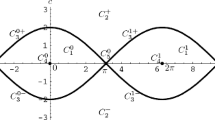Abstract
The classical Euler problem on stationary configurations of elastic rod in the plane is studied in detail by geometric control techniques as a left-invariant optimal control problem on the group of motions of a two-dimensional plane E(2).
The attainable set is described, the existence and boundedness of optimal controls are proved. Extremals are parametrized by the Jacobi elliptic functions of natural coordinates induced by the flow of the mathematical pendulum on fibers of the cotangent bundle of E(2).
The group of discrete symmetries of the Euler problem generated by reflections in the phase space of the pendulum is studied. The corresponding Maxwell points are completely described via the study of fixed points of this group. As a consequence, an upper bound on cut points in the Euler problem is obtained.
Similar content being viewed by others
References
A. Agrachev, B. Bonnard, M. Chyba, and I. Kupka, Sub-Riemannian sphere in Martinet flat case. ESAIM Control Optim. Calc. Var. 2 (1997). 377–448.
A. A. Agrachev and Yu. L. Sachkov, Geometric control theory. Fizmatlit, Moscow (2004); English translation: Control theory from the geometric viewpoint. Springer-Verlag, Berlin (2004).
_____, An intrinsic approach to the control of rolling bodies. Proc. 38th IEEE Conf. Decision and Control, Phoenix, Arizona, USA, December 7–10 (1999), Vol. 1, pp. 431–435.
S. S. Antman, The influence of elasticity on analysis: Modern developments, Bull. Amer. Math. Soc. 9 (1983), No. 3, 267–291.
V. I. Arnold, Singularities of caustics and wave fronts. Kluwer (1990).
D. Bernoulli, 26th letter to L. Euler (October, 1742). In: Correspondance mathématique et physique, Vol. 2, St. Petersburg (1843).
J. Bernoulli, Véritable hypothèse de la résistance des solides, avec la demonstration de la corbure des corps qui font ressort. In: Collected works, Vo. 2, Geneva (1744).
G. Birkhoff and C. R. de Boor, Piecewise polynomial interpolation and approximation. In: Approximation of Functions (Proc. Symp. General Motors Res. Lab., 1964), Elsevier, Amsterdam (1965), pp. 164–190.
M. Born, Stabilität der elastischen Linie in Ebene und Raum. Preisschrift und Dissertation, Göttingen, Dieterichsche Universitäts-Buchdruckerei Göttingen (1906). Reprinted in: Ausgewählte Abhandlungen, Göttingen, Vanderhoeck & Ruppert (1963), Vol. 1, pp. 5–101.
U. Boscain and F. Rossi, Invariant Carno–Caratheodory metrics on S 3, SO(3), SL(2), and lens spaces. SIAM J. Control (2008), accepted.
R. Brockett and L. Dai, Non-holonomic kinematics and the role of elliptic functions in constructive controllability. In: Nonholonomic Motion Planning (Z. Li and J. Canny, eds.), Kluwer, Boston (1993), pp. 1–21.
L. Cesari, Optimization. Theory and applications. Problems with ordinary differential equations. Springer-Verlag, New York–Heidelberg–Berlin (1983).
L. Euler, Methodus inveniendi lineas curvas maximi minimive proprietate gaudentes, sive solutio problematis isoperimitrici latissimo sensu accepti. Lausanne, Geneva (1744).
M. Golumb and J. Jerome, Equilibria of the curvature functional and manifolds of nonlinear interpolating spline curves. SIAM J. Math. Anal. 13 (1982), 421–458.
S. Jacquet, Regularity of sub-Riemannian distance and cut locus. Preprint No. 35, May 1999, Universita degli Studi di Firenze, Dipartimento di Matematica Applicata “G. Sansone,” Italy.
C. G. J. Jacobi, Volresungen über Dynamik. G. Reimer, Berlin (1891).
J. W. Jerome, Minimization problems and linear and nonlinear spline functions, I: Existence. SIAM J. Numer. Anal. 10 (1973), 808–819.
____, Smooth interpolating curves of prescribed length and minimum curvature. Proc. Amer. Math. Soc. 51 (1975), 62–66.
V. Jurdjevic, The geometry of the ball-plate problem. Arch. Rat. Mech. Anal. 124 (1993), 305–328.
_____, Non-Euclidean elastica. Amer. J. Math. 117 (1995), 93–125.
_____, Geometric control theory. Cambridge Univ. Press (1997).
D. F. Lawden, Elliptic functions and applications. Springer-Verlag (1989).
A. Linnér, Unified representations of non-linear splines. J. Approx. Theory 84 (1996), 315–350.
A. E. H. Love, A treatise on the mathematical theory of elasticity. Dover, New York (1927).
R. S. Manning, J. H. Maddocks, and J. D. Kahn, A continuum rod model of sequence-dependent DNA structure. J. Chem. Phys. 105 (1996), 5626–5646.
R. S. Manning, K. A. Rogers, and J. H.Maddocks, Isoperimetric conjugate points with application to the stability of DNA minicircles. Proc. Roy. Soc. London A 454 (1998), 3047–3074.
D. Mumford, Elastica and computer vision. In: Algebraic geometry and its applications (C. L. Bajaj, Ed.), Springer-Verlag, New York (1994), pp. 491–506.
O. Myasnichenko, Nilpotent (3,6) sub-Riemannian problem. J. Dynam. Control Systems 8 (2002), No. 4, 573–597.
L. Saalschütz, Der belastete Stab. Leipzig (1880).
Yu. L. Sachkov, Exponential mapping in generalized Dido’s problem. Mat. Sb. 194 (2003), No. 9, 63–90.
_____, Discrete symmetries in the generalized Dido problem. Mat. Sb. 197 (2006), No. 2, 95–116. 235–257.
_____, The Maxwell set in the generalized Dido problem. Mat. Sb. 197 (2006), No. 4, 123–150. 595–621.
_____, Complete description of the Maxwell strata in the generalized Dido problem. Mat. Sb. 197 (2006), No. 6, 111–160.
_____, Maxwell strata in Euler’s elastic problem. Preprint SISSA 04/2007/M (January 15th 2007), Scuola Internazionale Superiore di Studi Avanzati, Trieste, Italy; available at: arXiv:0705.0614 [math.OC], 3 May 2007.
_____, Conjugate points in Euler’s elastic problem. J. Dynam. Control Systems (accepted), available at: arXiv:0705.1003 [math.OC], 7 May 2007.
_____, Exponential mapping in Euler’s elastic problem. In preparation.
A. V. Sarychev and D. F. M. Torres, Lipschitzian regularity of minimizers for optimal control problems with control-affine dynamics. Appl. Math. Optim. 41 (2000), 237–254.
S. Timoshenko, History of strength of materials. McGraw-Hill, New York (1953).
C. Truesdell, The influence of elasticity on analysis: The classic heritage. Bull. Amer. Math. Soc. 9 (1983), No. 3, 293–310.
E. T. Whittaker and G. N. Watson, A course of modern analysis. An introduction to the general theory of infinite processes and of analytic functions; with an account of principal transcendental functions. Cambridge Univ. Press, Cambridge (1996).
S. Wolfram, Mathematica: a system for doing mathematics by computer. Addison-Wesley, Reading, MA (1991).
Author information
Authors and Affiliations
Corresponding author
Additional information
This work was partially supported by the Russian Foundation for Basic Research, project No. 05-01-00703-a.
Rights and permissions
About this article
Cite this article
Sachkov, Y.L. Maxwell strata in the Euler elastic problem. J Dyn Control Syst 14, 169–234 (2008). https://doi.org/10.1007/s10883-008-9039-7
Received:
Revised:
Published:
Issue Date:
DOI: https://doi.org/10.1007/s10883-008-9039-7



